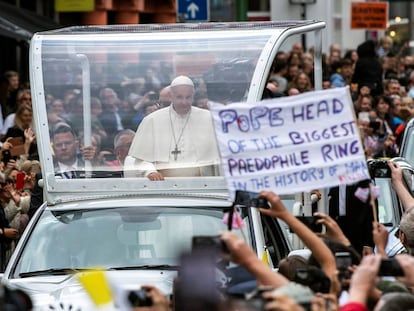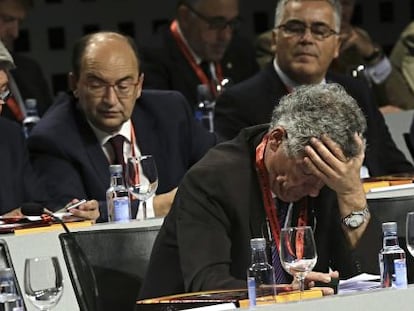What FIFA and the Vatican have in common
Both institutions have a long history of unacceptable behavior on the part of some of their members

Few human activities arouse as much passion as religion and sports. Within Christianity – the world’s largest religion – the Catholic Church has the greatest number of adherents, while soccer has the most fans of any sport. The Vatican rules the Catholic Church, and FIFA – the International Federation of Association Football – leads global soccer. Both are important institutions even though Pope John Paul II once famously clarified that “out of all the unimportant things, football is the most important.”
The origins, histories, and raison d’être of these two institutions could not be more different. The Vatican is a sovereign state that has been around for centuries while FIFA was founded in Switzerland a mere 114 years ago. Nevertheless, despite their profound differences, they also have interesting similarities.
In soccer as in the Catholic Church, the followers are much better than their leaders
For example, they share an odd paradox in that both are essentially European institutions, but most of their followers live in less-developed countries. And neither of them has any women in their leadership. And the global standard-bearers of Catholicism and soccer are Argentines: Pope Francis and Lionel Messi.
Both organizations control vast financial resources. Although the Holy See has an immense artistic and real estate heritage, its main sources of income come from investments, rents from its property holdings, and donations from individuals, dioceses, and other institutions. Its finances are opaque, but an investigation by The Economist concluded that in 2010 the budget of the Catholic Church in the United States was $170 billion, most of it channeled to charitable organizations.
FIFA’s income is derived from broadcast rights, product merchandising, ticket sales, and investments. Between 2015 and 2018 these revenues totaled more than $5.5 billion.
Illinois Attorney General
In recent years both the Vatican and FIFA have found themselves in legal hot water. In May 2015, more than a dozen plainclothes policemen stormed the Baur au Lac, a luxury hotel in Zurich, where the annual meeting of FIFA officials was taking place. Seven of them were arrested. A few months later, the scene was repeated. At 6am on December 3, 2015 the Swiss police arrived at the Baur au Lac again and arrested more members of the FIFA leadership. While the police who conducted the raids were Swiss, they were acting at the request of US authorities. The FBI had been investigating corruption in FIFA for three years. The US Department of Justice accused FIFA of “unbridled, systemic and entrenched corruption.” FIFA executives were receiving illegal payments in exchange for voting in favor of a particular country that aspired to host the World Cup, or wanted broadcast rights, or special marketing privileges.
On the initiatives of a US Attorney in New York, the FBI, and other US government agencies, several FIFA leaders were extradited, tried, and sentenced to prison. The leadership of the organization was replaced. The corruption scandal led several other countries to launch their own investigations. It is interesting to note that the revelations of corruption in FIFA did not surprise those familiar with its inner workings. It was an open secret that many of its decisions were for sale.
What was a surprise is that those who ended up confronting FIFA’s culture of corruption were the prosecutors, judges, and law enforcement agencies of the United States – a country where soccer does not yet have the weight in society that it enjoys almost everywhere else.
The legal problems of the Vatican are well known and have interesting similarities with those of FIFA, even though its corruption was financial while the Catholic Church was mired in sexual abuse scandals.
In both there is a long history of unacceptable behavior on the part of some of its members, and an equally long history of denial of the problem, concealment, tolerance, obstruction and impunity. Again, and despite the fact that Catholicism is not the leading religious denomination in the United States, it was the authorities of that country that most aggressively confronted sexual abuse in the Church.
A recent article in The Washington Post notes that “the swift and sweeping response by civil authorities contrasts sharply with the Vatican’s comparatively glacial pace.” The Illinois Attorney General has said that “the Catholic Church has proven that it cannot police itself. And civil authorities can’t let the Church hide child sexual-abuse allegations as personnel matters. They’re crimes. We need a full accounting of the Church.” In the United States, 15 states have initiated extensive criminal investigations into sexual abuse. In contrast, according to statistics, in European countries where Catholics are the majority of the population, silence and impunity remain the norm. But this is about to change.
Not only because civil society is more activated and empowered, information is more accessible, and crimes are more difficult to hide. But also because, in soccer as in the Catholic Church, the followers are much better than their leaders.
Twitter @moisesnaim
Tu suscripción se está usando en otro dispositivo
¿Quieres añadir otro usuario a tu suscripción?
Si continúas leyendo en este dispositivo, no se podrá leer en el otro.
FlechaTu suscripción se está usando en otro dispositivo y solo puedes acceder a EL PAÍS desde un dispositivo a la vez.
Si quieres compartir tu cuenta, cambia tu suscripción a la modalidad Premium, así podrás añadir otro usuario. Cada uno accederá con su propia cuenta de email, lo que os permitirá personalizar vuestra experiencia en EL PAÍS.
¿Tienes una suscripción de empresa? Accede aquí para contratar más cuentas.
En el caso de no saber quién está usando tu cuenta, te recomendamos cambiar tu contraseña aquí.
Si decides continuar compartiendo tu cuenta, este mensaje se mostrará en tu dispositivo y en el de la otra persona que está usando tu cuenta de forma indefinida, afectando a tu experiencia de lectura. Puedes consultar aquí los términos y condiciones de la suscripción digital.











































